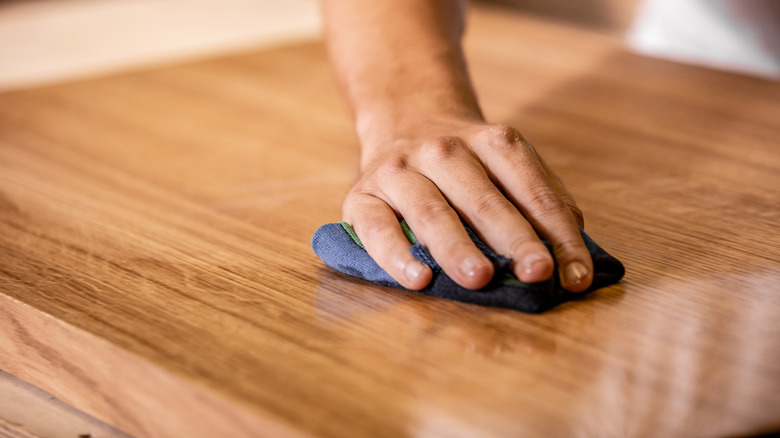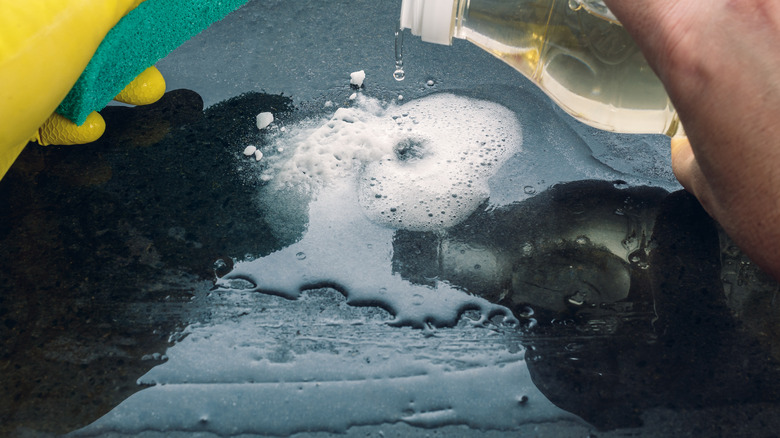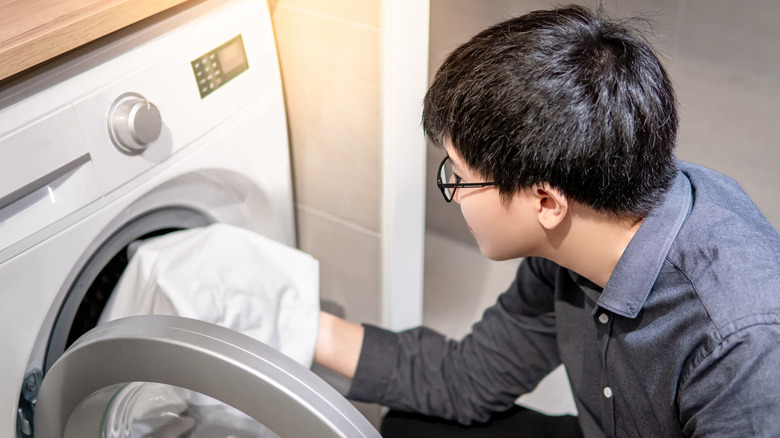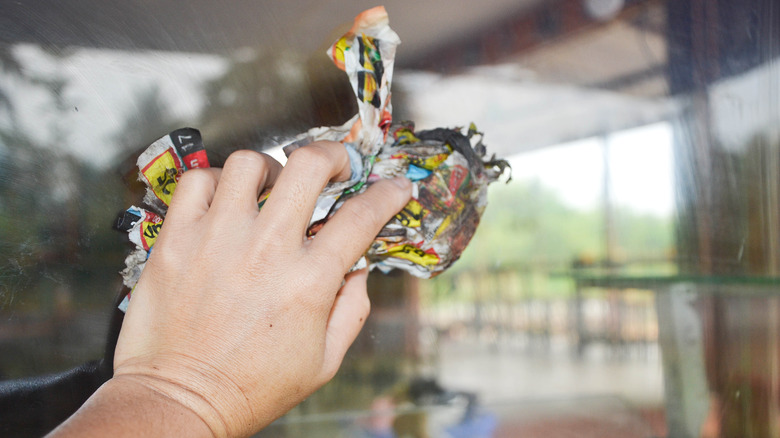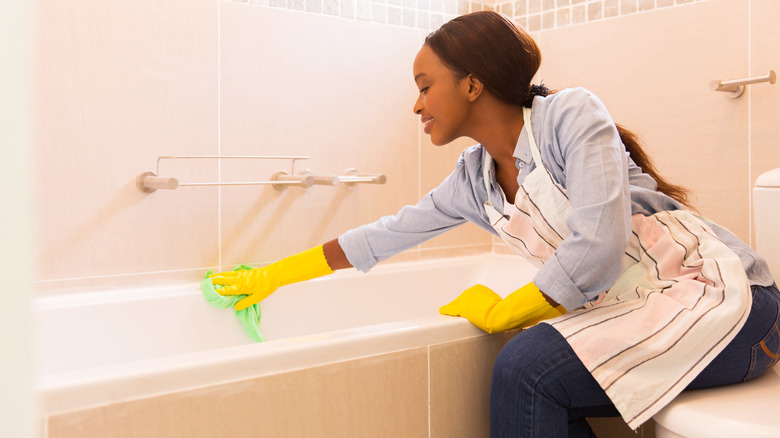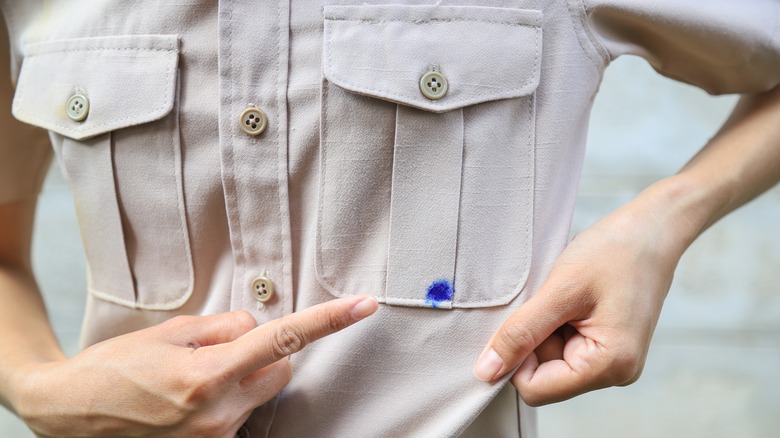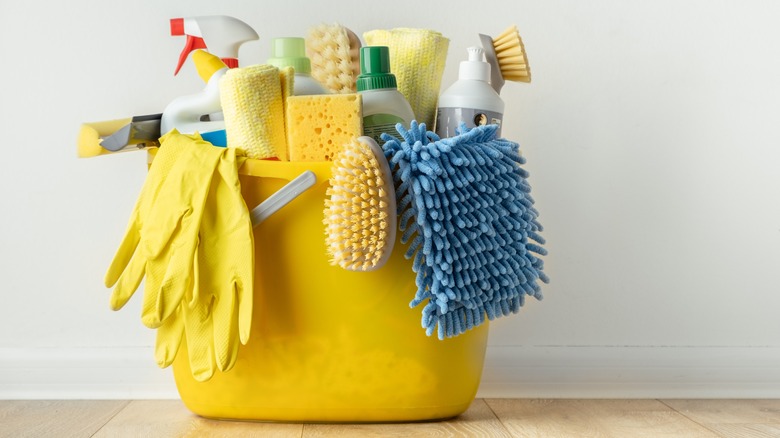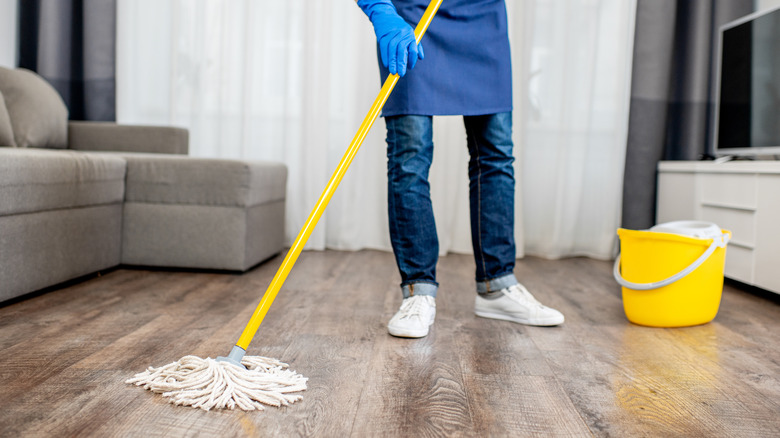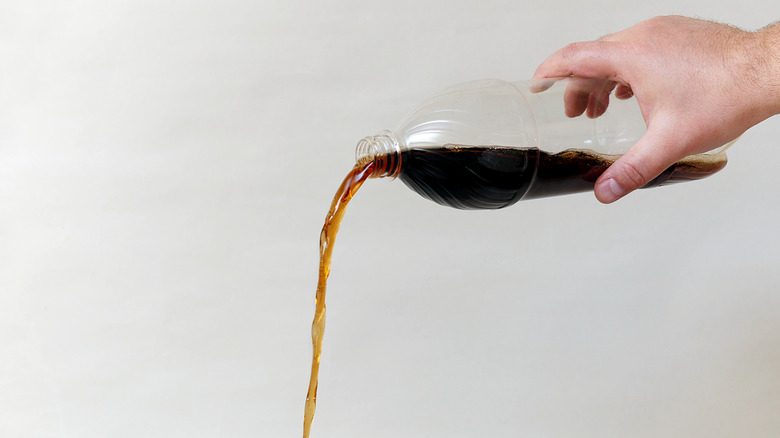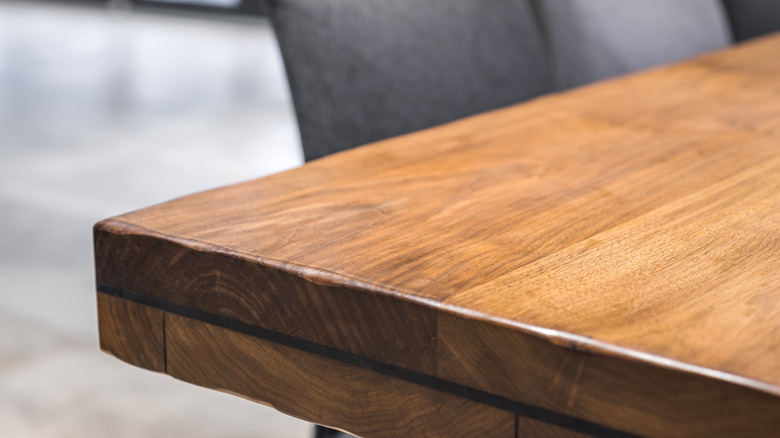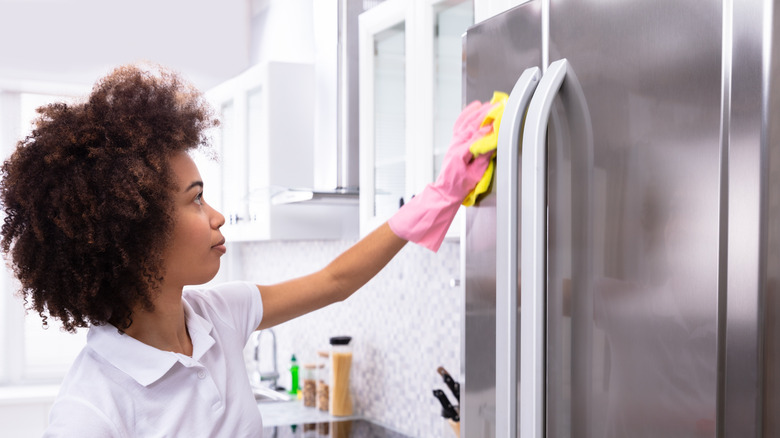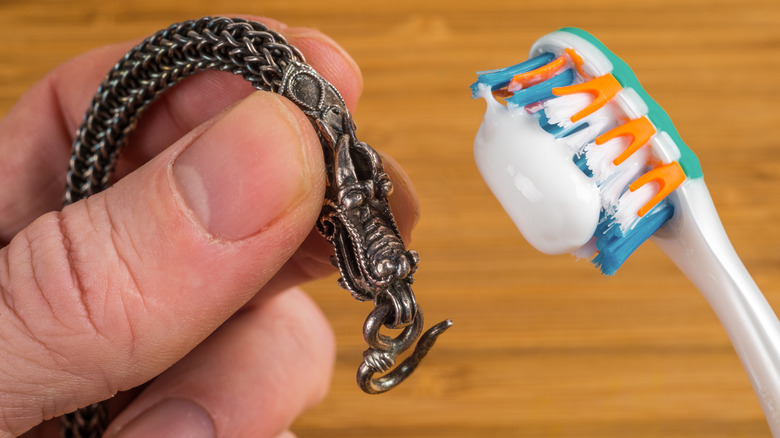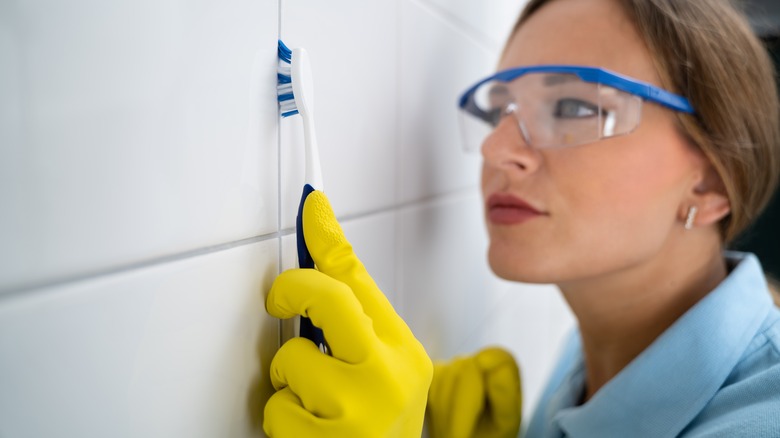You're Better Off Skipping These Popular Household Cleaning Hacks
We may receive a commission on purchases made from links.
We all want a cleaner home, but this can sometimes lead us astray into the world of cleaning hacks, especially if they promise quick results with minimal effort. You can often find them shared online through social media, and these hacks claim to revolutionize how you keep your home sparkling clean. However, not all is as it seems in the world of cleaning shortcuts. Some of these hacks are detrimental to your home instead of benefitting it. This is not just about debunking myths — it's about keeping your home and the people in it healthy and safe. The supposed efficiency is a massive draw with these hacks, but many fall short, don't deliver on what they promise, or cause damage that can be expensive and time-consuming to fix.
You must understand the science behind these hacks and why they don't work as promised. From methods that weaken your clothing and compromise your appliance's integrity to those that leave a nasty residue on something they're supposed to clean, you want to cut through the noise. Understanding why you should skip these popular household hacks is about adopting a more informed approach to cleaning and preserving your home for years to come.
A vinegar and baking soda combo to clean
It's a viral hack to mix baking soda and vinegar to clean because you get a fun fizz for a few seconds when they combine. However, therein lies the downside. Mixing baking soda and vinegar makes them neutralize one another, leaving you with water and a form of salt called sodium acetate. So, the cleaning power baking soda and vinegar have on their own disappears. Also, vinegar's more acidic nature can damage certain surfaces, like marble and granite, and cause etching if applied. The etching will cause your pretty counters or surfaces to look dull and worn, and it's expensive to repair or replace them. Also, many people mistakenly believe that the small fizzing action means it's working, but this reaction doesn't do much on a chemical level.
Instead of using an acidic product (and accidentally damaging your expensive countertops), buy specialized cleaners designed to work on specific materials in your home. These products come specially formulated to address each material's needs, ensuring you get a thorough clean without damage. For example, using a pH-neutral cleaner on stone surfaces helps keep the protective layer and shine in place without discoloring or etching. Instead of vinegar and baking soda, a mild dish soap diluted in water works well to clean many surfaces.
Lemon juice as a color-safe bleach
People tout lemon juice as a color-safe, natural alternative to bleach for your laundry. It's true that lemon juice can brighten your whites, but just how safe and effective it is for colored fabrics is a little murkier. When you expose your lemon juice-treated fabrics to sunlight, the citric acid acts like traditional bleach, and you can end up with patchy spots. This is a big problem with dark or colorful clothing; even a hint of bleach can ruin the look. Also, the results you get with white fabrics aren't always the same, making lemon juice slightly less reliable if you're looking for a method to enhance or keep your brightness levels with your white clothing.
If you're looking for consistent, dependable results when you do laundry, find products specifically designed to be used on it. Modern stain removers and bleaching agents, like OxiClean MaxForce Laundry Stain Remover Spray, are formulated for color-safe laundering and will give you much more consistent results. They'll remove stains without impacting the color of the fabric. A trusted bleaching solution for white clothing guarantees you'll get a brighter end product without an unpredictable outcome. These products have to undergo dozens of quality tests to ensure consistent results with different fabrics and colors, giving you peace of mind when using them.
Newspapers to clean windows
Millions of people have used newspapers to clean their windows for years, highlighting it as a cost-effective way to get a streak-free glass. However, this method has big problems, so you don't want to use it to clean your windows. One of the biggest issues is that newspapers can leave ink residue and steaks behind, no matter how much you scrub. As the paper rubs against the glass, it transfers ink that you smear and smudge, and getting it back off is difficult. Newspaper paper quality has also gone down over the years to make it more cost-effective for printers, and this makes it much less effective as a cleaning tool and more likely to disintegrate and leave debris.
To get clean and spotless windows or mirrors, the trick is to use products and tools that come specifically designed to clean glass. Microfiber cloths are excellent for cleaning glass because they have fine fibers that pick up grime, dirt, and liquid without leaving any lint or streaks. Using them and a specialized glass cleaner ensures you get crystal-clear glass without any residue. There are commercial-grade window cleaners available for dirtier glass, and they'll cut through fingerprints, grease, and dust without much effort from you. A squeegee removes the cleaner without streaking if you don't have a microfiber cloth handy.
Toilet bowl cleaner in your tub and on tile
Using your toilet bowl cleaner as a catch-all product to clean your bathtubs, sinks, vanities, and other surfaces is a hack many people like because of how potent this formula is. But, the harsh chemical makeup of toilet cleaner can cause damage. These products have ingredients that help get rid of the mineral deposits and stains you find in your toilet, and these are very different from the soap scum and dirt that builds up on your tiles and bathtubs. The highly alkaline or acidic nature of toilet bowl cleaners dulls certain finishes and erodes grout. Over time, this breaks down the bathroom surfaces' integrity, and you'll have to replace or repair them sooner.
To ensure your bathroom is clean and the surfaces look great, and that they last as long as possible, you want to stick to cleaners formulated for specific materials in your bathroom. Bathroom-specific cleaners, like Clorox Disinfecting Bathroom Cleaner, can tackle hardwater stains, soap scum, and mildew without damaging your bathtub finish, grout, or tiles. If you want more natural and eco-friendly options, vinegar and water mixtures or a baking soda paste are mild solutions. These alternatives clean while being gentle on bathroom surfaces, and using them with microfiber cloths or soft sponges won't degrade or scratch the finish.
Hairspray for ink stains
For years, it's been claimed that hairspray is a quick way to get ink stains out of fabric, and this hack comes from the belief that the alcohol in hairspray will break down the ink and make it easier to wash out. However, there are several reasons not to clean an ink stain with hairspray. First, today's hairsprays have less alcohol and higher amounts of additives and fixatives, which can worsen the stain. Instead of lifting the ink, they'll make it stick more firmly to the fabric's fibers, setting it in and making it more difficult to remove. You also run the risk of getting a sticky residue left behind from the hairspray that runs, and this can attract more dirt to make the stain worse. So, how effective this hack is depends on the hairspray's formula, making it a less reliable method for tackling pesky ink stains.
Some products come specially designed for the purpose of removing ink stains effectively. You can also try applying rubbing alcohol, gently dabbing at the stain, and working slowly to lift it from the fabric before you wash it. The alcohol will get deep into the fabric's fibers and dissolve the ink; the washer takes care of the rest. Follow any instructions you get with your specific stain remover, and test it on a hidden spot first to ensure it doesn't damage anything.
Mixing different products, believing they'll clean better
Mixing various household products in an attempt to make a more potent cleaner is a gamble with substantial health risks attached. Many cleaning products have chemicals that, when mixed with other products, react and create harmful gasses or cause corrosive mixtures. For example, mixing bleach and ammonia or any acidic cleaner will release toxic chlorine or chloramine gas. Both cause eye, throat, or nose irritation, respiratory issues, or more severe health problems. The chemical reactions will also damage the surfaces you want to clean, leaving discoloration or etching that is tough or impossible to fix.
To keep yourself and your items safe when you clean, always follow the usage instructions on your cleaning product labels and look at the listed ingredients. The guidelines help maximize your product's cleaning power while minimizing risks. If you have a challenging cleaning project, choose a cleaner that is specifically formulated to address the issue instead of mixing products. For example, you can buy specialized cleaners to remove soap scum, tough stains, or grease, and each works without being mixed with something else. If you're unsure of how compatible two products are, it's best to not mix products to avoid making a dangerous mistake.
Laundry pods in your mop bucket
Adding laundry pods as a floor cleaner might seem like a clever shortcut that leverages the detergent's strong cleaning agents to get your floor sparkling. But laundry pods have a specific formula that works for washing clothes, not cleaning your floor. Laundry pods have a chemical composition that makes them react differently on floor surfaces, and they can leave a sticky buildup, blemishes, or streaks. This residue will attract more grime and dirt. You'll have to clean your floor more often as a result. Laundry pods are very alkaline, and they can actually strip the finish from wood floors, which is why mop water turns brown when using this method.
To avoid these problems, use floor cleaners that come formulated for use on the specific surface you want to clean, like laminate, tile, or wood. These product manufacturers thoroughly test everything to ensure you get an excellent clean without damaging the floor or leaving residue. Following the instructions on the bottle regarding the application and dilution ensures you get the best results possible without any issues. If you want a more environmentally friendly or gentler solution, options like diluted vinegar or specific eco-friendly floor cleaners can offer a safe and effective alternative.
Cola to clean toilets
You may think that pouring cola into your toilet bowl is an excellent way to make it sparkle. But, while cola can tackle lime or rust stains in the toilet because it's acidic, and you may even see them start to fade, it falls short when it comes to dealing with bacteria and disinfecting. Cola doesn't have any germ or bacteria-killing properties, which pose health risks, especially in germ-heavy spots in your house, like the bathroom. If you grab only cola to clean your toilet, you will get a space that looks wonderful to the naked eye, but it doesn't ensure it's hygienic or safe. You'll only get a temporary shine. Additionally, cola works best to tackle stains if it sits for hours or overnight, and you may not have this kind of time.
Instead of running out and buying a bottle of cola next time you want to clean your toilet, pick a dedicated toilet bowl cleaner that disinfects as it shines. These cleaners come specially formulated to remove visible stains and kill bacteria and germs you can't see. These specialized products will be the most effective, and many feature ingredients that stave off rust and lime buildup as well.
Olive oil for wood furniture
Olive oil can add a quick shine to your wooden furniture to make it look nice, but it's not an excellent idea for long-term care. Olive oil will go rancid or spoil with prolonged air exposure. When this happens, your furniture will lose its shine, and it could start to smell. Also, using too much oil attracts dust and dirt, creating a sticky buildup that can eventually damage your furniture's finish and appearance. Olive oil can work temporarily if you maintain your furniture frequently and don't mind polishing it weekly. But, for many, this method is more trouble than it's worth with the potential for damage.
Instead of going for olive oil, use products specifically designed to shine and clean wood furniture. These dedicated cleaners and polishes come formulated to enhance your furniture's shine without leaving a sticky residue. They also have ingredients that prevent dust attraction and don't go bad from exposure to the air. You can also use mineral oil as a natural alternative because it won't spoil, gives your furniture a shine without attracting dust, and it's easy to apply. Since the goal is to preserve your furniture's longevity and appearance, opting for products that offer protection and shine without the downsides of spoilage or dust buildup is critical.
Salt for scrubbing stainless steel
You may have heard that you can use salt around the house, including on stainless steel as a scrubbing agent. While it's true that salt, mainly when you use lemon with it, can help scrub away tough, burnt-on food from your stainless steel pans, there's a catch. Salt is very abrasive, especially coarse varieties. When you use coarse salt on stainless steel, especially on more delicate surfaces like countertops or appliances, it can scratch or etch the finish. The scratches take away from the stainless steel's shine and can be spots for bacteria and grime to build up. While this abrasiveness is useful in certain instances, like scrubbing pans, you have to be very careful to avoid etching the surface.
To keep your stainless steel surfaces and appliances looking shiny and clean, it's best to steer clear of salt or harsh abrasives. Instead, go for safer cleaning methods. Use a soft cloth with a bit of dish soap and warm water for daily or spot cleaning. For more stubborn stains or to get a deeper clean, use a specialized stainless steel cleaner. Mixing a 1:1 ratio of vinegar and water in a spray bottle and wiping down your stainless steel also works for a gentle, natural method.
Toothpaste to clean silver
Using toothpaste to clean silver jewelry is a method that has been around for a long time, and it promises to bring the shine back to tarnished silver. Toothpaste, especially the abrasive types, can remove tarnish, but there are risks. For example, scrubbing pearls, opals, or soft gemstones can scratch and dull the finish, and you want to avoid using it on gold due to potential reactions with the metal. However, if you don't have anything else to use, non-gel toothpaste is a slightly safer option, but it still requires careful application and extreme caution to avoid damaging the jewelry. So, while it seems like a convenient solution, especially if you want to polish up a piece quickly, the risk of damaging your jewelry outweighs the benefits.
The most effective and safest way to clean and maintain your silver jewelry is to buy a product specially designed to strip tarnish without damage. These products are gentle on metal, ensuring your silver stays shiny. Also, using a silver cleaning cloth can help keep your silver jewelry looking good for longer. For a DIY approach, mix a solution of warm water and mild dish soap. Soak your jewelry before lightly scrubbing it with a soft brush and then rinse. By choosing the right products and methods, you can preserve the beauty and integrity of your silver items for years and avoid the potential pitfalls of quick fixes.
Bleach to whiten grout
It's very common to bleach grout lines to brighten up the areas between tiles in the bathroom and kitchen. Bleach will make your grout look cleaner and brighter, and this is a quick fix for stained or dingy grout; you can even use a bleach pen in a pinch. However, if you use it constantly to clean grout, the harsh chemical will weaken the grout, possibly leading to erosion. Not only does it impact the appearance, it could lead to loose or falling tiles. In addition, constant bleach exposure can cause eye, skin, and respiratory irritation.
To maintain or refresh your grout without damaging it, it's a good idea to go for less harsh mixtures. Mixing baking soda into a paste with lemon juice or water cleans the grout without chemicals. For regular maintenance, you can buy grout-specific cleaners. You'll keep your tiled areas looking neat without damaging them. However, if you need a deeper clean, you can use bleach sparingly, especially if you dilute it before applying. Just be sure to follow the manufacturer's instructions for dilution to minimize any potential damage.
